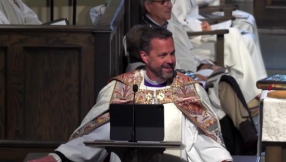
We need to take the Bible literally again.
So said biblical scholar Prof Iain Provan last night, giving a lecture titled 'Seriously Literal Interpretation: The Reformation and the Right Reading of Scripture' at the London School of Theology.
In his Laing Lecture, Prof Provan, who is Marshall Sheppard Professor of Biblical Studies at Regent College, Vancouver, said we need to recover a sense of reading the Bible literally, but not literalistically.
In a year that celebrates 500 years since the Protestant Reformation, Provan was commending what he saw as the view that the Reformers such as Martin Luther and John Calvin had of the Bible.
This does not mean that Provan believes the world was made in six days 6,000 years ago or that metaphor and poetry should be ignored. What it does mean, he said, was listening to the actual voice of the author of the text.
Metaphors, for example, should be taken literally, but will be misunderstood if taken literalistically.
Provan said: 'We must differentiate between literal readings and literalistic. A literalistic reading understands "pitching a tent" to require throwing it.'
Of course, the word 'literally' can confuse for two reasons. Some people take it to mean 'literalistically', while others take it to really mean 'metaphorically'.
Someone might say, to use an example Provan gave, that they were so excited that they were 'literally glued to their seat'. They don't really mean that due to adhesive they were 'literally' unable to leave their seat. They are using a common metaphor to communicate their captivation and they wish to express their thought emphatically.
To take this point to the Bible, Provan is emphasising that 'literal' readings are concerned not with word-for-word translations, but with the intention of the author. Much biblical interpretation can ignore the author, focusing instead on history, or personal experience, or spiritual guidance of some kind, while pretending that the intention of the author does not matter or cannot be heard.
The four (confusing) ways
Provan said that Protestant interpretation of the Bible has broadly split into four ways of reading it.
Historical critics take a modern approach, using tools of linguistic translation and historical reconstruction to determine the truth 'behind' the texts.History takes priority. The texts are read seeking a 'literal' meaning, but often at the expense of not interpreting texts in their literary or theological context.
Another approach is the post-modern one. Post-modern readers focus on the independence of texts from their authors and on how readers construct their own meaning out of texts. They will probably challenge previously dominant perspectives and explore new ways to read the text. Provan named the 'emergent Church' movement as an example of the influence of post-modern thinking.
A third approach reacts strongly to the post-modern way, in pursuit of the 'single, definite and fixed meaning' expressed in the biblical text. This theologically conservative will champion the Bible's innerancy and expresses caution about 'modern' readings, including the bearing of scientific developments on interpretation.
A final approach comes from 'counter-reformational Protestants' who question the legacy of the Reformation, seeing it as something to lament, not celebrate. They look towards the more ancient approaches of the Church for ways to read the Bible, looking for different layers of meaning and asserting 'spiritual' interpretations of scripture texts. For example, they may celebrate the use of 'allegorising', taking certain passages as symbols of later revealed truths.
Summing up these four 'ways', Provan said that these approaches, encountered together, can sow great confusion in the Church. In particular, their vast differences can cause people to doubt the truth and coherence of the Bible, questioning whether it can really be understood.
To counter this, Provan commended Calvin and Luther's 'literal' reading of the Bible.
This does not mean ignoring historical details, grammatical nuances or theological interpretations, he said. Rather, it means understanding them as the author intends. He quoted Luther who once wrote: 'Become a text critic, and learn about the grammatical sense, whatever grammar intends, which is about faith, patience, death, and life.'
When this becomes the essence of the approach, the complexity of a text is taken seriously, while emphasising the accessibility of God's word to the lay person.
The now and not yet
Provan concluded by speaking about typology, a tool within language that allows texts to relate, connect and prefigure one another. He gave the example of the royal themes in Psalm 2. The psalm is written in exile, when there is no king, but it prefigures Jesus, Provan says, looking forward to the true king who is to come.
He quoted scholar Hans Frei's description of typology: 'Without loss to its own literal meaning or specific temporal reference, an earlier story (or occurrence) [becomes] a figure of a later one.' Provan called typology 'the now and not yet of biblical hermeneutics'.
Where does authority come from? How does God speak, and can he be understood? These are the questions the Reformers wrestled with and considered to be of utmost importance.
Provan suggested that lack of confidence in the Bible and our ability to understand it is an increasing problem within contemporary churches. He wants people to return to an understanding the understands both the richness and simplicity of God's word.
Does this mean anyone can interpret scripture? 'Everyone can do it. If they learn how to do it,' Provan says.
A glance at trends in Christian news and culture should remind one well just how divided many Christians are about how to read the Bible. In many ways, confusions about the Bible mean the Church is more divided now than ever. In this year that looks back on the legacy of the Reformation, Provan is using the Reformers as a guide for helping a Church in crisis. It is one that takes seriously all aspects of advanced interpretation and scholarship, but also asks simply: 'What is the writer trying to say?'
You can follow @JosephHartropp on Twitter













